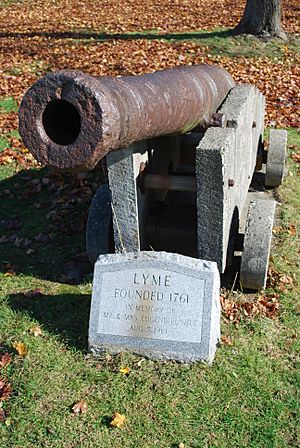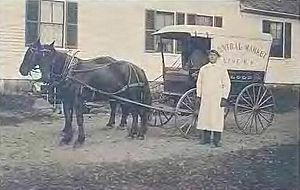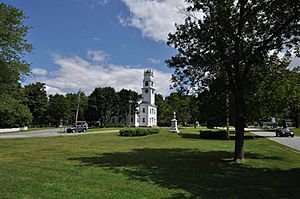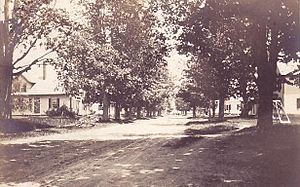Lyme, New Hampshire facts for kids
Quick facts for kids
Lyme, New Hampshire
|
|
|---|---|
|
Town
|
|

Location in Grafton County, New Hampshire
|
|
| Country | United States |
| State | New Hampshire |
| County | Grafton |
| Incorporated | 1761 |
| Villages | Lyme Lyme Center |
| Area | |
| • Total | 55.0 sq mi (142.5 km2) |
| • Land | 53.8 sq mi (139.4 km2) |
| • Water | 1.2 sq mi (3.1 km2) 2.19% |
| Elevation | 548 ft (167 m) |
| Population
(2020)
|
|
| • Total | 1,745 |
| • Density | 32/sq mi (12.5/km2) |
| Time zone | UTC-5 (Eastern) |
| • Summer (DST) | UTC-4 (Eastern) |
| ZIP Codes |
03768 (Lyme)
03769 (Lyme Center) |
| Area code(s) | 603 |
| FIPS code | 33-44260 |
| GNIS feature ID | 0873654 |
Lyme is a charming town located in Grafton County, New Hampshire. It sits right next to the beautiful Connecticut River. In 2020, about 1,745 people called Lyme home.
It's a great place for nature lovers, with the Chaffee Natural Conservation Area. You can also find the Dartmouth Skiway here, perfect for winter sports! The famous Appalachian Trail passes through Lyme's eastern forests.
Contents
History of Lyme
Long ago, the Abenaki Native American people lived here. One group, the Sokokis, lived near Post Pond. They called this area Ordanakis.
Lyme was officially created as a town in 1761. This happened thanks to colonial Governor Benning Wentworth. Many of the first people who received land grants in Lyme were from Massachusetts and Connecticut. However, most of them never settled here. They sold their land to others.
The first settlers arrived in 1764, mostly from those same states. Before Lyme was founded, this land was known as Tinkertown. In the late 1770s, Lyme tried to join Vermont, but this effort was not successful.
Historic Town Common
Lyme has a beautiful town common. It is surrounded by old houses and public buildings. These buildings date from the late 1700s to the early 1900s.
In the 1830s, Stagecoaches traveled through Lyme. They were on the "Boston Turnpike" from Montreal. These coaches would stop at the Lyme Inn, which was built in 1809. The inn has been updated recently.
Next to the inn is a 200-year-old Congregational church. Its original bell was made by Paul Revere in 1815. Later, a new bell was put in. It was made by Henry N. Cooper & Co. in Boston.
A special hand-wound clock mechanism from E. Howard & Co. strikes the hour. Behind the church, you can see a row of horse sheds. These sheds date back to 1810.
This row of 27 sheds is the longest line of connected horse sheds in New England. It might even be the longest in the United States. Each shed used to have the owner's name above the door. Those signs are still there today.
Geography and Nature
Lyme covers about 142.5 square kilometers (55 square miles). Most of this area is land, with a small part being water. The town is drained by several brooks. These brooks all flow into the Connecticut River. The river forms Lyme's western border and the state line with Vermont.
The center of Lyme village is the Lyme Common. It is about 1.5 miles east of the Connecticut River. Lyme is a rural town, meaning it has a lot of open land and nature.
Most of the buildings and homes are in the western part of town. This area is along the Connecticut River and New Hampshire Route 10. The eastern half of Lyme is mostly covered by forests.
Lyme's Ponds and Mountains
Lyme is home to four large ponds. These are Post Pond, Pout Pond, Trout Pond, and Reservoir Pond.
Holts Ledge is a tall cliff that faces east. It is part of the Dartmouth Skiway. The edge of the cliff has a fence. This fence helps protect falcons that live there.
The highest point in Lyme is the top of Smarts Mountain. It is 3,238 feet (987 meters) above sea level. A fire tower was built on Smarts Mountain in 1915. You can see this tower from far away. It makes Smarts Mountain stand out from other local mountains. The Appalachian Trail crosses the tops of both Holts Ledge and Smarts Mountain.
People of Lyme
In 2010, there were 1,716 people living in Lyme. There were 705 households and 503 families. The population density was about 31 people per square mile.
Most people in Lyme are White (96.9%). A small number are Asian (1.1%), African American (0.3%), or Native American (0.3%). About 2.4% of the population is Hispanic or Latino.
About 28.5% of households had children under 18 living with them. Most households (61.3%) were married couples. About 23.5% of households had someone living alone.
The average age of people in Lyme was 47.4 years. About 22.4% of the population was under 18. About 17.8% were 65 or older.
Many people in Lyme work in education and health care (50.9%). Other common jobs are in professional, scientific, and management fields (9.6%). Construction and manufacturing make up 8.4% of jobs.
The average yearly income for a household in Lyme was estimated at $110,781 between 2010 and 2014. For families, it was $130,795. Only a small number of families (0.6%) and people (3.1%) lived below the poverty line.
Education in Lyme
Lyme has two schools for students from kindergarten to 8th grade. One is a public school, and the other is an independent school.
Lyme School
The Lyme School is the public K-8 school. It has about 200 students. Since 2018, it offers full-day kindergarten. The Lyme School often ranks among the top 5-10% of schools in New Hampshire.
After 8th grade, students from Lyme go to high school in nearby towns. They can attend Thetford Academy in Thetford, Vermont. Other options include Hanover High School in Hanover, New Hampshire. Some students also go to Hartford High School in Hartford, Vermont, Lebanon High School in Lebanon, New Hampshire, or St. Johnsbury Academy in St. Johnsbury, Vermont. Most students choose between St. Johnsbury Academy, Thetford Academy, and Hanover High.
Crossroads Academy
Crossroads Academy is an independent K-8 school. It was started in 1991 in Hanover. Now, it is located in Lyme on a large 140-acre wooded campus.
The school serves over 140 students. These students come from up to 50 miles away. Crossroads Academy has 39 teachers and staff members.
Places to Visit
- Lyme Historians Museum
- Appalachian Trail
- Dartmouth Skiway
Famous People from Lyme
- Fred Hovey Allen (1845–1926), a clergyman, author, and pioneer in art reproduction.
- Jonathan Child (1785–1860), the first mayor of Rochester, New York.
- David Marston Clough (1846–1924), who was the 13th governor of Minnesota.
- Amos P. Cutting (1839–1896), an architect.
- Trina Schart Hyman (1939–2004), a famous illustrator of children's books.
- Arthur Latham Perry (1830–1905), an important American economist who supported free trade.
- Baxter E. Perry (1826–1906), the second mayor of Medford, Massachusetts.
- Albert Cushing Read (1887–1967), who led the first seaplane flight across the Atlantic in 1919.
- Mikaela Shiffrin (born 1995), an alpine ski racer and US Olympic gold medalist.
See also
 In Spanish: Lyme (Nuevo Hampshire) para niños
In Spanish: Lyme (Nuevo Hampshire) para niños





